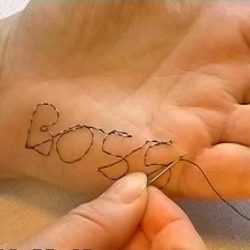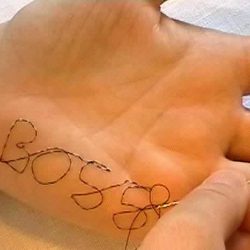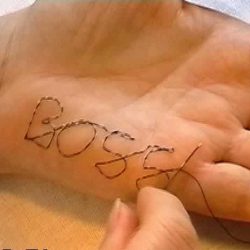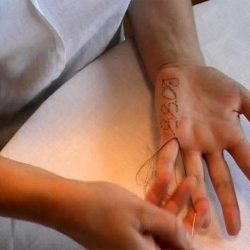A performance video (D)
52 minutes, Analogue Beta SP, PAL 4:3
2005 Trailer 3.30 Minutes
Insurance value DVD: 200 €uro
Close-up video images show Ury’s right-hand stitching the word “Boss” into the palm of her left-hand; the thin sewing needle, threaded with fine black cotton, does not incur any bleeding.
Röslein Sprach… the video title (trans.: The little rose spoke…) refers to a line from the second verse of “Heidenröslein”, a poem by Goethe 1799, that Schubert set to music in 1815 and that can also be heard in the video. The song tells of a red rose, whose only defence against the attacks of a wild boy are the ineffective pricks of her thorns.
Your Rules 2004 is an artwork that incorporates a photographic image of the artist’s hand embroidered with the word ‘Boss’ and a poster for Hugo Boss men’s fragrances, in which a young man displays his hand inscribed with the handwritten logo ‘your rules’.
Coded within the video are allusions to the fascist activities of the fashion house Hugo Boss AG during the Third Reich era, when an élite workforce of seamsters and seamstresses was specially assembled from all over Nazi-occupied areas of Europe, to work as poorly paid forced labour, making uniforms in the Boss Metzingen workshop, in Germany.
The general public was only first made aware of this scandal in 1997, when the name Hugo Ferdinand Boss appeared in Swiss bank account lists from the Nazi period. Hugo Boss has since only paid the absolute minimum required compensation into a fund set up by the German government but it is unlikely that the few surviving victims will ever receive reimbursement, given the late decision to undertake anything and the slow machines of bureaucracy.
The Boss credo of re-writing the rulebook to suit one’s personal needs, is reflected in their current German television advertising campaign 2004, for Hugo Boss eau de toilette: accompanying the voice-over: “your fragrance, your rules”, a tattooed youth holds up the palm of his hand close to the camera, where one can read the handwritten statement: “your rules”. Tanya Ury parodies this with her hand-sewn testimony “Boss”.
The video imagery also refers to the photography of Daniel Buetti, where a variety of fashion logos appear to be sewn into the fashion model´s skin; Buetti’s working process does not in fact, involve any kind of injury to the model: his photographic images, having had holes punched through from the back, are then re-photographed.
The glorification or belittlement of violence towards women in literature starts early on, with the Heidenröslein1, for example. You might think that the symbolic representation of a brutal rape, set to music or not, wouldn’t be a suitable subject for school education, least of all placed on the same level with actual love songs. Goethe and Schubert aside, the last verse is only a lightly disguised terror scene: “And the rough boy picked the rose,
little red rose on the heath,
and the red rose fought and pricked,
yet she cried and sighed in vain,
and had to let it happen.2”
The belittlement arises because the rapist, a fully-fledged, or at least sexually mature man, comes across as a “wilder Knabe”, a “wild boy”, who has symbolically carried out the act on a flower, although distinctly bruiser and weak girl are inferred and the fact that the terror is washed over in the trilled away refrain “Röslein, Röslein, Röslein rot /Röslein auf der Heiden“ (Little rose, little rose, little rose red,
Little rose of the field.3)
The song is false, because it presents a crime as something unavoidable and as a love scene, moreover. In Helke Sander’s controversial documentary film BeFreier und Befreite (Liberators take Liberties), a male choir is deployed to sing the “Heidenröslein“ unambiguously and without comment in the context of the mass rapes of the Second World War. For a girl or woman to find such a song pretty, she would have to suppress more of her human self-awareness than it is worth, not to mention her erotic needs.4
1 “Heidenröslein” or “Heideröslein” (“Rose on the Heath” or “Little Rose of the Field”) is a poem by Johann Wolfgang von Goethe, published in 1799. It was written in 1771 during Goethe’s stay in Strasbourg when he was in love with Friederike Brion, to whom the poem is addressed. en.wikipedia.org/wiki/… (ed. Tanya Ury)
2 Ibid 1.
3 en.wikipedia.org/wiki/…
4 Source: Ruth Klüger, Frauen lesen anders (Women Read Differently, in: Die Zeit, No. 48, 25.11.1994 www.stark-verlag.de/up…
Information
Concept and performance: Tanya Ury
Camera: Katja Butt
AVID Edit: Rainer Nelissen
Music: “Heidenröslein”, Schubert 1815, verse by Goethe 1779, contralto Janet Baker, Piano accompaniment Geoffrey Parsons, recorded in 1981.
Who’s Boss — a collection of works:
- Art Prize
- Boss Rune
- Hair Shirt
- Hair Shirt Army – Armee des härenen Gewandes
- Röslein Sprach…
- Selection
- shower proof
- Soul Brothers & Sisters
- sweatshop
- Your Rules
This video extract is the last three and a half minutes of the DVD.
Presentation
2005 ”Always glad to be of service …”, ifa Galerie, Berlin (D)
2005 (26.3. – 23.4 Opening 24th March 7 pm), slide reading 20th April 150 m³ Largus, Ausstellungs- und Projektraum (exhibition and project room) Mozartstrasse 9, Cologne (D)
2005 “Stets gern für Sie beschäftigt…” (”Always glad to be of service…”), Prora Dokumentationszentrum, Rügen (D)
2005 “Stets gern für Sie beschäftigt…” (“Always glad to be of service…”), Kunstverein Rosenheim (D) (Art Centre), Opening 9th November 2005, 19 hours. The exhibition is from 9th November till 6th January 2006
2005 (7.12.) Trailer, Conference: Jüdische Frauen in Geschichte und Gegenwart (Jewish Women in the Past and Present), Konrad-Adenauer-Stiftung, Wesseling nr. Bonn (D)
2006 (27.2.) Peer Critique, trailer, Ben Uri Gallery, The London Jewish Museum (GB)
2006 (5.4.) Professional Practice Seminar with trailer, Fine Art Department, Sheffield Hallam University (GB)
2006 (6.4.) Trailer, presented in Seminar within Cathy Gelbin’s PhD. Conference course: Gender and Visual Arts, Holocaust Studies, Royal Holloway, London (D)
2006 (26.7. – 9.8.) Solo exhibition, Seminar in the exhibition, Tüzraktér Independent Cultural Centre, Budapest (HU)
2006 (28.8. – 3.9.) Who’s Boss as Seminar presentation, c.sides Festival, Jerusalem ICC (International Convention Center)(IL)
2006 (3.11. – 24.11.) Solo exhibition, 9 – 12 hours workshop with pupils from the Anne-Frank-Realschule (secondary modern). Opening 20 Uhr 3.11., Bochumer Kulturrat, (D)
2007 (23.3.) On the online Feminist Art Base: www.brooklynmuseum.org: video trailer, The Elizabeth A. Sackler Center for Feminist Art, The Brooklyn Museum, New York (USA)
2007 (4. – 7.4) Who’s Boss power point presentation Saturday, April 7th, 8:00 – 9:30 a.m., Salon K , Fashion, Appearance and Consumer Identity, Popular Culture Association, Thirty-seventh Annual Meeting, Boston Marriott, Boston (USA) www.popularculture.org
2008 (25.4. – 15.5) Röslein Sprach… (DVD), group exhibition, Open Space at the World-Ex-Position 08, Zentrum für Kunstprojekte Vienna www.openspace-zkp.org (AT)
2008 (16. – 18.5) Who’s Boss power point presentation in German, Limmud-Festival Werbellinsee (Jugenderholungs- und Begegnungsstätte) www.limmud.de (D)
Publications & Press
2005 (1.2.) Article: Grauen — nicht auf den ersten Blick — ifa-Galerie thematisiert Zusammenhänge zwischen Firmen und Naziverbrechen (Horror — not at first sight — ifa Gallery’s theme is the link between companies and Nazi crimes) by Robert Meyer, Neues Deutschland, Berlin (D) more
2005 (18.2.) Article: Hautnaht — ifa-Galerie: auf den Spuren des Holocaust (Skin Deep — ifa Gallery: In Search of Traces of the Holocaust), by Jens Hinrichsen, Tagesspiegel, Berlin (D) more
2005 (25.2.) Review with photo still Röslein sprach…, “Hugo’s dunklere Seite” (Hugo’s dark side) article by Martin Conrads, Netzeitung.de, Voice of Germany (D) more
2005 (7.3.) Article (unpublished) Röslein sprach…, Geld stinkt eben doch — Voll waren die Auftragsbücher zu Nazizeiten: Eine Ausstellung in der ifa-Galerie Berlin erinnert an Profiteure des Massenmords (Money stinks after all – the order books were full during the Nazi times: an exhibition in the ifa Gallery remembers those who profited from mass murder) by Matthias Reichelt, Berlin (D) more
2008 (11) Röslein Sprach… discussed in article on Tanya Ury (in German) by Hartmut Bomhoff,Jüdische Zeitung (monthly), Berlin (D) article as PDF www.j‑zeit.de
2019 (12) Tanya Ury’s artworks are discussed, as well as those of several other German artists, by Peter Chametzky, with images of lesser is me more or less, Who’s Boss: Röslein Sprach…, Who’s Boss: Art Prize Nr.4, and Who’s Boss: Hair Shirt Army (photo documentation, at the exhibition opening in EL-DE-Haus 2014, Cologne, by Peter Chametzky), in “’Turks, Jews, and Other Germans in Contemporary Art’: An Introduction,” The Massachusetts Review (60th Anniversary Issue), vol. 60⁄4 (Winter 2019): p. 655 – 681. massreview.org/sites/d… (USA)
Artist’s Writings & Publications
2005 (1.4.) Who’s Boss project presented in Anti-Flick-Collection Edition
of Texte zur Kunst, in the TAZ newspaper, Berlin (D)
2005 “Stets gern für Sie beschäftigt…” (”Always glad to be of service…”) catalogue, ifa Galerie, Berlin (D)
2006 (14−18.6) Who’s Boss as archival material, Performing Rights Library a four-day conference and accompanying programme of live events Performance Studies international (PSi) #12: Performing Rights, Queen Mary, University of London (GB)
2007 (7) Publication of Who’s Boss article in Translate/Narrate issue, volume 20, n.paradoxa, International Feminist Art Journal, London (GB)
2008 (26.4. – 15.5) Röslein Sprach… (DVD), Open Space at the World Expo, Vienna www.openspace-zkp.org/… (AT)



